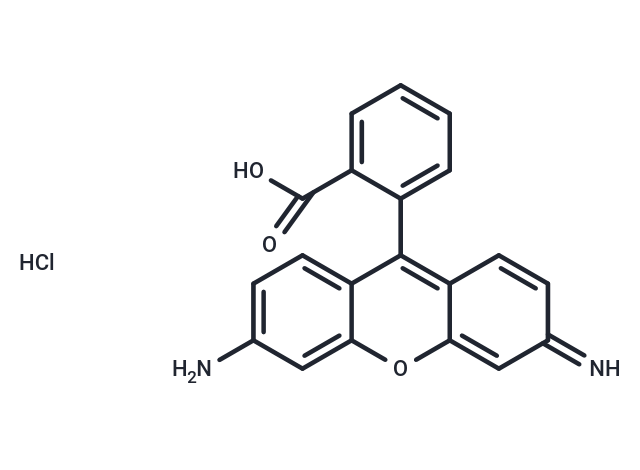Shopping Cart
Remove All Your shopping cart is currently empty
Your shopping cart is currently empty
Rhodamine 110 (RH110) is a xanthene dye similar to fluorescein and eosin.

| Pack Size | Price | USA Warehouse | Global Warehouse | Quantity |
|---|---|---|---|---|
| 50 mg | $42 | - | In Stock | |
| 1 mL x 10 mM (in DMSO) | $46 | In Stock | In Stock |
| Description | Rhodamine 110 (RH110) is a xanthene dye similar to fluorescein and eosin. |
| In vitro | Rhodamine 110 accumulates in mitochondria in its cationic form, altering the pH in this cellular compartment. It shows no cytotoxicity to human lymphoblastoid cells at concentrations below 10 μM, but induces cell death in Friend leukemia cells at concentrations above 100 μM[1]. |
| In vivo | Rhodamine 110 exhibits lower toxicity than its parent molecule, Rhodamine B, as evidenced by their respective intravenous LD50 values of 140.0 mg/kg for Rhodamine 110 and 89.5 mg/kg for Rhodamine B. Furthermore, Rhodamine 110 has been observed to increase testis weight in male rats and cause liver and kidney enlargement in both sexes, with male rats showing more pronounced effects. Pharmacokinetic studies involving oral and intravenous administration of Rhodamine 110 at various doses reveal that the area under the concentration–time curve (AUC) is dose-proportional, and clearance rates for orally administered doses indicate efficient processing by the body. Maximum plasma concentrations (Cmax) attained at different times post-administration suggest delayed absorption from the intestines into the bloodstream. This comprehensive analysis, employing noncompartmental model analysis with WinNonlin Standard Edition for pharmacokinetic parameter calculation, underscores the specific biodynamic profiles and comparative toxicity of Rhodamine 110. |
| Cell Research | I. Solution preparation 1. Mother solution preparation: Dissolve Rhodamine 110 in DMSO to obtain the required mother solution, usually 1-10mM. 2. Working solution preparation: Dilute the mother solution with PBS/DMEM/H2O to the required working solution, usually with a concentration range of 1-10μM. II. Protease detection in solution 1. Add Rhodamine 110 working solution to a sample containing protease (such as cell lysate or purified enzyme preparation). 2. Incubate the reaction mixture at an appropriate temperature for 30 minutes to 1 hour. 3. Measure the fluorescence signal at 498 nm excitation and 521 nm emission wavelength using a fluorescence spectrometer or microplate reader. 4. The increase in fluorescence indicates protease activity, which can be used to quantitatively analyze enzyme activity. II. Cell experiment 1. Add Rhodamine 110 working solution to cell culture medium and incubate for 30 minutes to 1 hour. 2. Use fluorescence microscopy to detect the fluorescence signal in the cells (excitation wavelength 498 nm, emission wavelength 521 nm). 3. Quantify the fluorescence intensity to evaluate the protease activity in the cells. |
| Synonyms | Rhodamine 110 chloride, RH110 |
| Molecular Weight | 366.8 |
| Formula | C20H15ClN2O3 |
| Cas No. | 13558-31-1 |
| Smiles | Cl.Nc1ccc2c(-c3ccccc3C(O)=O)c3ccc(=N)cc3oc2c1 |
| Relative Density. | 1.2504 g/cm3 (Estimated) |
| Color | Purple |
| Appearance | Solid |
| Storage | keep away from direct sunlight | Powder: -20°C for 3 years | In solvent: -80°C for 1 year | Shipping with blue ice/Shipping at ambient temperature. | |||||||||||||||||||||||||||||||||||
| Solubility Information | DMSO: 45 mg/mL (122.68 mM), Sonication is recommended. | |||||||||||||||||||||||||||||||||||
Solution Preparation Table | ||||||||||||||||||||||||||||||||||||
DMSO
| ||||||||||||||||||||||||||||||||||||
| Size | Quantity | Unit Price | Amount | Operation |
|---|

Copyright © 2015-2026 TargetMol Chemicals Inc. All Rights Reserved.